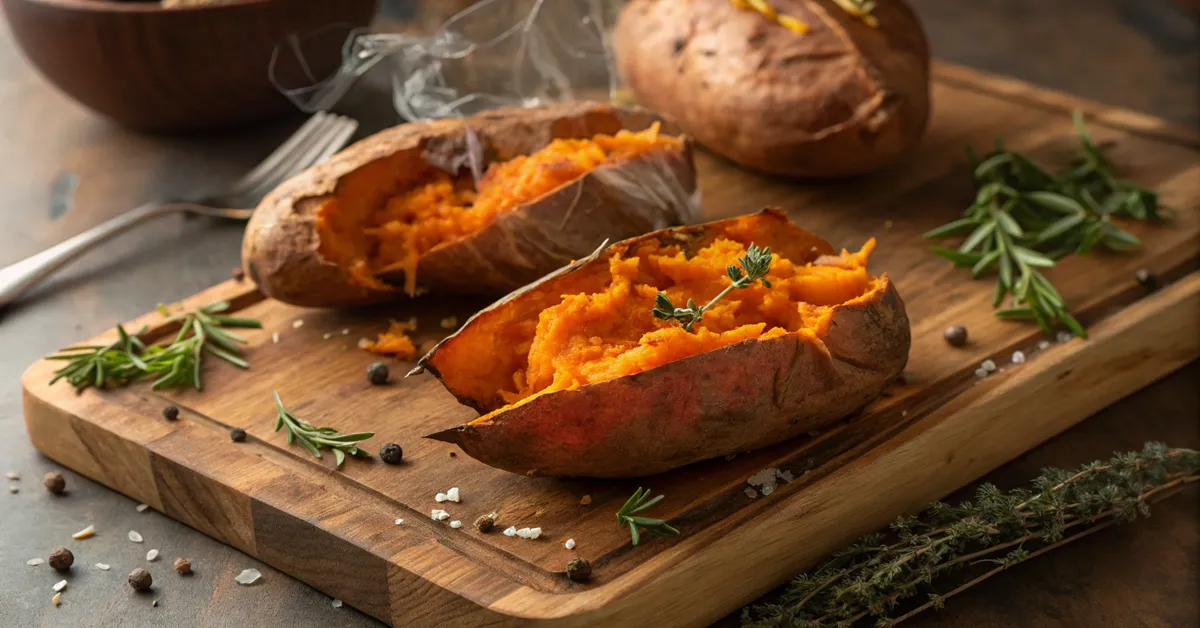Polenta with Eggs and Greens: The Perfect Mediterranean Comfort Dish
From Italian Kitchen to Your Table: The Polenta Breakfast Magic
It was a misty spring morning in Calabria. Nonna Rosa stood in her small sunlit kitchen, apron dusted with cornmeal, stirring a pot of bubbling polenta. The smell of garlic-infused olive oil mingled with sautéed greens, and a soft poached egg sat atop the golden base like a crown. “Mangia,” she whispered, sliding the plate toward me. That single bite—silky polenta, earthy greens, creamy yolk—was the moment I fell in love with Polenta with Eggs and Greens.
In this article, we’ll explore this humble yet nourishing dish that’s rooted deep in Italian and Mediterranean cooking traditions. You’ll discover the health benefits, authentic methods, cultural insights, and a full recipe to recreate this bowl of comfort at home. And if you’re looking to elevate your next brunch or breakfast, this dish is hearty, gluten-free, vegetarian-friendly, and endlessly versatile.
Check out our flavorful twist on breakfast in this loaded veggie omelette:
👉 Discover great ideas like this one
Table of Contents
Table of Contents

Polenta with Eggs and Greens: The Perfect Mediterranean Comfort Dish
- Total Time: 45 minutes
- Yield: 2 servings 1x
Description
Creamy, wholesome, and packed with Mediterranean flavor, this Polenta with Eggs and Greens recipe is a warm, satisfying dish perfect for brunch or dinner. With garlicky sautéed greens and a runny poached egg on top, it’s nutritious, gluten-free, and full of comforting textures.
Ingredients
🍴 Ingredients:
- 1 cup cornmeal (medium or coarse grind)
- 4 cups water or low-sodium vegetable broth
- 1 tablespoon olive oil or unsalted butter
- ¼ cup grated Parmesan or Pecorino Romano (optional)
- ¼ teaspoon sea salt
- 4 cups fresh spinach or mixed leafy greens (kale, chard, arugula)
- 1 tablespoon olive oil
- 2 garlic cloves, minced
- Pinch of red pepper flakes (optional)
- 2 large egg
- 1 teaspoon white vinegar (for poaching eggs)
- Salt and pepper to taste
- Optional: crumbled feta, chopped parsley, toasted nuts or seeds, lemon zest
Instructions
👨🍳 Instructions:
In a medium pot, bring 4 cups of water or broth to a simmer.
Gradually whisk in 1 cup cornmeal to prevent lumps. Stir constantly.
Lower heat and cook for 30–40 minutes until polenta thickens. Stir often.
Stir in olive oil or butter, salt, and cheese if using. Cover and set aside.
In a skillet, heat olive oil and sauté garlic for 30 seconds.
Add greens, season with salt, pepper, and chili flakes. Sauté until wilted (3–4 mins).
In a separate pot, bring 2–3 inches of water with vinegar to a simmer.
Crack eggs into small bowls, swirl the water, and gently drop each egg in.
Poach for 3 minutes. Remove with a slotted spoon.
Divide polenta into bowls, top with greens and eggs, and garnish as desired.
Notes
Use vegetable broth instead of water for deeper flavor.
Swap spinach with any leafy green you have on hand.
To make it dairy-free, skip the cheese or use plant-based alternatives.
For a make-ahead version, prepare the polenta in advance and reheat with a splash of broth.Soft-boiled eggs also work great if you prefer to prep in bulk.
- Prep Time: 10 minutes
- Cook Time: 35 minutes
- Category: Mediterranean Breakfast Recipes
- Method: Stovetop, Poached
- Cuisine: Mediterranean, Italian
Nutrition
- Serving Size: 1 bowl
- Calories: 310 kcal
- Sugar: 1.5 g
- Sodium: 330 mg
- Fat: 14 g
- Saturated Fat: 4 g
- Unsaturated Fat: 9 g
- Trans Fat: 0g
- Carbohydrates: 34 g
- Fiber: 5 g
- Protein: 13 g
- Cholesterol: 180 mg
More Than Just Porridge: Polenta’s Colorful Mediterranean History
Not Just Italian! The Worldwide Love Affair with Cornmeal Porridge
Polenta is a traditional dish made by boiling ground cornmeal into a thick, creamy porridge. While it’s often associated with Northern Italy, versions of cornmeal porridge appear in cultures across the globe—from the American South’s grits to Romania’s mamaliga. In Italy, polenta was a staple of the working class for centuries, praised for its simplicity and satisfying texture.
In its earliest form, polenta was made from other grains like millet or spelt. But once maize arrived from the Americas in the 16th century, corn became the grain of choice. By the 18th century, it had evolved into the rich, golden comfort food we know today.
How eggs and greens became part of traditional polenta dishes
Adding eggs and greens to polenta is not just a modern health trend—it has deep cultural roots. In peasant communities of Italy, it was common to top leftover polenta with seasonal greens and a freshly laid egg. This simple combination eventually gave rise to what we now love as Polenta with Eggs and Greens.
Whether it’s kale from the Tuscan hills or chard from Liguria, leafy greens are central to Mediterranean cuisine. Pairing them with eggs and creamy polenta isn’t just smart—it’s tradition. And when served together in a balanced bowl, Polenta with Eggs and Greens delivers comfort and nutrition in every bite.
In fact, many variations of polenta with eggs and greens are still served throughout Italy today—from rustic trattorias to elegant countryside B&Bs.
Looking for inspiration? Try this Mediterranean breakfast bowl for more nourishing breakfast ideas:
👉 Looking for inspiration? Try this
The 3-Ingredient Miracle Bowl Nutritionists Are Raving About
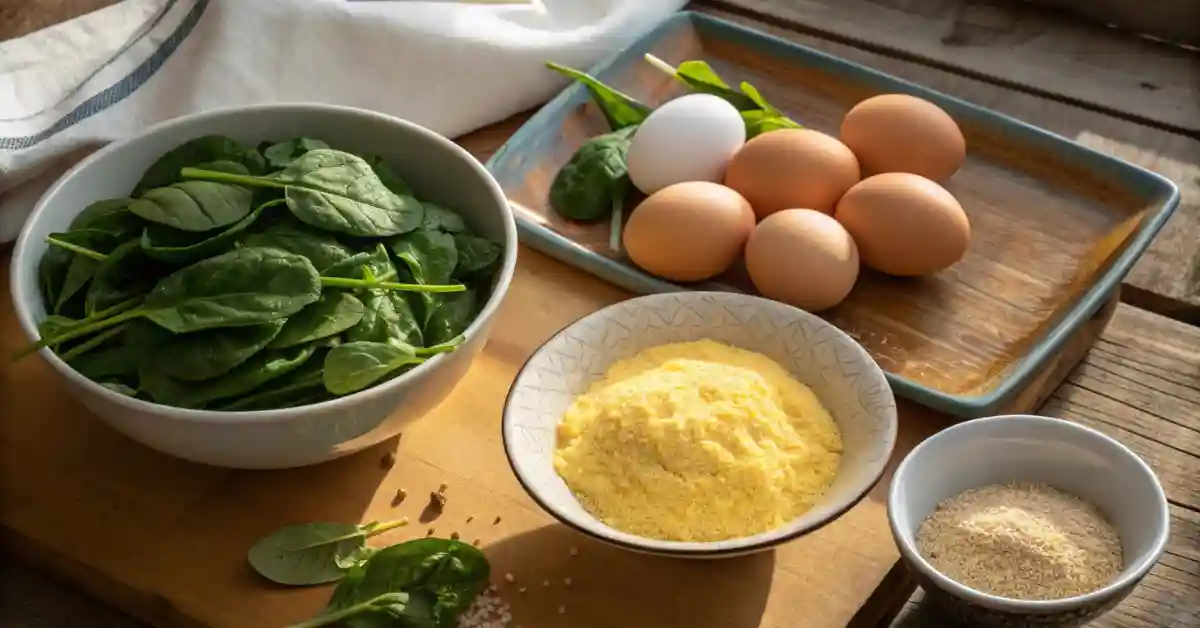
How This Humble Dish Delivers Every Nutrient You Need
Let’s talk nutrition. A bowl of polenta with eggs and greens offers more than just flavor—it delivers real nourishment. Each component plays a role:
- Polenta, Polenta, crafted from ground cornmeal, is naturally gluten-free and abundant in complex carbohydrates. It provides sustained energy and is gentle on the digestive system.
- Eggs bring high-quality protein and healthy fats. They also supply essential vitamins like B12, choline, and D, which are crucial for brain function and bone health.
- Greens, especially dark leafy varieties like kale, spinach, and chard, are dense in fiber, calcium, potassium, and vitamins A, C, and K.
Put them all together and you get a dish that satisfies hunger, supports heart health, and fuels your day—whether you’re kicking off breakfast or winding down with a light dinner.
Polenta with eggs and greens isn’t just a dish—it’s a smart choice for anyone looking to nourish themselves with real food.
Is Polenta Healthy? A Closer Look at Its Benefits
Yes—polenta is healthy when prepared with whole, fresh ingredients. On its own, polenta is low in fat and sodium. It’s a great source of:
- Complex carbs: Ideal for energy without blood sugar spikes
- Iron: Especially when combined with greens like spinach
- Fiber: Supports digestion when using whole-grain cornmeal
When paired with eggs and greens, polenta’s nutritional profile is significantly improved. The fat in eggs helps in absorbing fat-soluble vitamins present in the greens, creating a synergy that makes this dish greater than the sum of its parts. Plus, it fits well into numerous dietary lifestyles, as it’s naturally vegetarian and gluten-free. You can easily modify it for dairy-free or low-fat options by swapping butter for olive oil and opting for egg whites to lower cholesterol.
Check out how this watermelon feta pasta salad combines health and flavor beautifully:
👉 Don’t miss our recipe here
🍽️ Nutritional Snapshot (Per Serving Approx.)
| Ingredient | Calories | Protein | Fiber | Key Vitamins |
| Polenta (1 cup cooked) | 120 | 2g | 1g | Iron, B6 |
| Poached Egg (1 large) | 70 | 6g | 0g | B12, Choline |
| Spinach (1 cup cooked) | 40 | 5g | 4g | A, C, K, Folate |
| Olive Oil (1 tsp) | 40 | 0g | 0g | Vitamin E, K |
As shown, each component supports different body functions while keeping calories reasonable. It’s a win for health-conscious food lovers.Want more balanced vegetarian options? Explore this crustless spinach and feta quiche:
👉 Discover great ideas like this
How to Make Creamy Polenta Base Like a Chef
From Lumpy To Luxurious: Ramsay’s Foolproof Polenta Method”
When preparing Polenta with Eggs and Greens, the key is nailing that creamy base. Gordon Ramsay’s method gives your polenta a luxurious texture that perfectly contrasts the firmness of sautéed greens and the richness of a poached egg. A flawless bowl of Polenta with Eggs and Greens begins with proper stirring, good ingredients, and a little love.
Start with 4 parts water to 1 part cornmeal. Bring the water to a simmer, then whisk in the cornmeal slowly to avoid lumps. Ramsay prefers to stir continuously for up to 45 minutes, using a wooden spoon and adding a pinch of salt during the process.
Once the mixture becomes smooth and thick, he finishes with a generous spoon of butter and a splash of milk or cream. For a more Mediterranean touch, replace cream with extra virgin olive oil and grated Pecorino Romano cheese. The result? A luxurious, creamy foundation for your eggs and greens.
Looking for an extra protein-packed morning? Try our spinach and mushroom omelette:
👉 Check out this tasty idea
The Wooden Stick Trick That Makes Italian Polenta Special
Traditional Italian methods also pair well with the modern dish. By following ancestral cooking styles, your Polenta with Eggs and Greens takes on not only the flavor of the past but the soul of it.
The classic version is simple—just cornmeal, water, and salt—but Italians sometimes enhance it with herbs, cheese, or even bits of pancetta. It’s typically spread onto a wooden board, cooled slightly, and sliced. However, for polenta with eggs and greens, you’ll want to keep it soft and creamy.
Some regions, like Lombardy or Veneto, serve it with mushrooms or meat sauces, while in Tuscany, you’ll often see polenta paired with beans or sautéed greens. The point is—polenta is versatile, and it’s meant to absorb the character of whatever you serve with it.
This makes it the perfect canvas for toppings like runny eggs and vibrant, garlicky greens.
Try our take on Mediterranean comfort with spinach and feta—perfect as a side to creamy polenta:
👉 Don’t miss our favorite here
Pro Tip: Use Vegetable Broth Instead of Water
Want to infuse your polenta with eggs and greens with more flavor? Swap water for vegetable broth. You’ll instantly deepen the taste without extra work or calories.
You can also stir in:
- Garlic-infused olive oil
- Crumbled feta or goat cheese
- A dash of black pepper and fresh thyme
These small touches take a basic bowl to restaurant-level deliciousness.
Leafy Love: How to Pick Perfect Greens for Your Polenta
Best Greens to Use: Spinach, Kale, Chard, and More
When crafting the perfect polenta with eggs and greens, choosing the right leafy greens makes all the difference. The Mediterranean diet is known for its seasonal produce, and leafy greens are at its core.
Let’s look at the best options:
| Leafy Green | Flavor Profile | Best Pairing Tip |
| Spinach | Mild and tender | Add raw at the end for a silky finish |
| Kale | Earthy and robust | Blanch first, then sauté with garlic |
| Swiss Chard | Slightly sweet, juicy | Use the colorful stems too—packed with nutrients |
| Arugula | Peppery and sharp | Top the dish fresh for a bright contrast |
| Collards | Hearty and dense | Slow-cook to soften texture |
Spinach is perhaps the most popular. Its gentle flavor and short cooking time make it ideal for a quick, nutrient-rich topping on your polenta with eggs and greens. Swiss chard adds visual flair, while kale brings a toothsome chew that contrasts beautifully with creamy polenta.
For even more depth, you can mix greens—combining bitter and mild varieties balances out the flavor beautifully.
Crisp-Tender or Silky Soft? How to Cook Greens Like a Pro
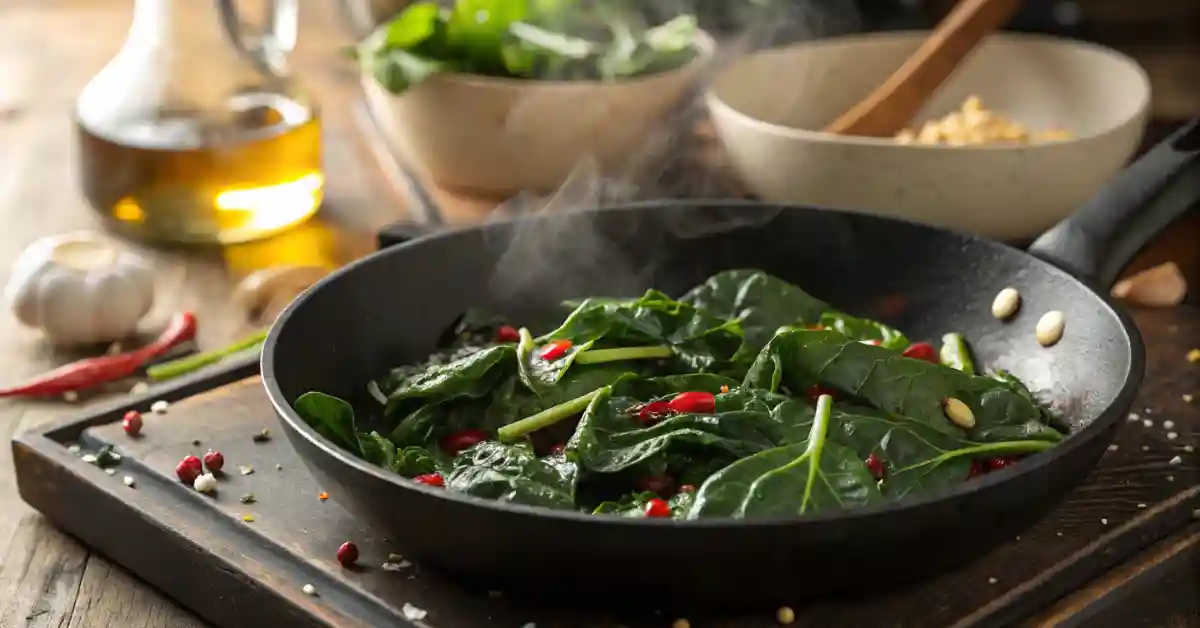
So how should you prepare your greens? It depends on the experience you want. Sautéing in olive oil with a pinch of sea salt and a clove of garlic gives the greens depth and a hint of smokiness. It’s the most popular method in Mediterranean kitchens.
Steaming, on the other hand, is ideal if you’re aiming for a cleaner, lighter taste and want to preserve more nutrients. But without a splash of lemon or spice, steamed greens can taste flat—so always season well.
For a traditional Italian vibe, sauté your greens until they’re wilted and glossy, then layer them generously on top of your polenta. Finally, place your egg on top. The contrast between the creamy base, warm greens, and rich yolk is what makes polenta with eggs and greens so comforting and crave-worthy.
Want another Mediterranean recipe loaded with greens? Try this spinach and feta pasta:
👉 Check out this wholesome recipe
Bonus Tip: Add Texture with Nuts or Seeds
Once your greens are ready, sprinkle them with toasted pine nuts, sesame seeds, or crushed walnuts. Not only does this add crunch, but it also boosts the nutritional value of your polenta with eggs and greens.
Silky, Jammy or Crispy? The Egg Magic Your Polenta Deserves
Can You Add Egg to Polenta? Techniques That Work
Absolutely—you can add egg to polenta, and there are several creative ways to do it. Whether you’re blending it directly into the mix or placing it delicately on top, eggs enhance flavor, texture, and nutrition.
Here are a few techniques:
- Stirring in a raw egg at the end of cooking gives your polenta an ultra-rich, custard-like texture. This is perfect for breakfast bowls or lighter dinners.
- Incorporate eggs into the polenta by forming wells in the cooked mixture, cracking an egg into each well, and baking until the whites are firm. This method works great for family-style dishes.
- Topping polenta with cooked eggs—the most common and flexible method. Whether poached, fried, or soft-boiled, placing the egg on top of creamy polenta creates contrast and visual appeal.
If you’re making polenta with eggs and greens for brunch, soft-poached eggs with runny yolks add that perfect creamy bite that blends into the polenta like a silky sauce.
Sunny Side Up vs Poached: The Ultimate Polenta Showdown
Each egg style offers a unique vibe. Here’s a quick guide to help you decide which egg to use for your polenta with eggs and greens masterpiece:
| Egg Style | Texture | Best With |
| Poached | Soft, runny yolk | Creamy polenta and sautéed greens |
| Sunny-side up | Crispy edges, soft yolk | Adds color and crunch |
| Soft-boiled | Jammy yolk | Easy meal prep and bowl-style servings |
| Hard-boiled | Firm and sliceable | Best for on-the-go lunches |
| Scrambled | Fluffy and rich | Quick weekday variation |
For a traditional Mediterranean touch, we recommend a poached or sunny-side-up egg. These methods preserve the yolk’s creaminess, adding moisture and richness that melts right into the dish.
To poach your egg perfectly:
- Boil water with a splash of vinegar.
- Crack the egg into a small bowl.
- Stir the water to create a vortex and gently drop the egg in.
- Cook for 3 minutes for soft yolks, then remove with a slotted spoon.
Place it gently atop your polenta and greens. When the fork cuts in, the yolk will flow, enriching every bite of your polenta with eggs and greens.
Quick Variation: Egg-in-a-Hole Polenta Slice
If you let your polenta cool and slice it into rounds, you can cut a hole in the center and cook an egg right inside. This “egg-in-a-hole” version is fun, portable, and especially kid-friendly.
Beyond Basic: Unexpected Toppings That’ll Make Your Polenta Sing
The Italian Way: Traditional Polenta Toppings That Never Fail
Traditionally, polenta was served as a hearty base for stews, braised meats, and rustic vegetable ragùs. In Northern Italy, families would spread it on a large wooden board and top it with wild mushrooms, sausage, or a drizzle of tomato sauce.
But with the rise of plant-forward eating, polenta with eggs and greens has become a modern classic—combining tradition with health-conscious simplicity.
One of the reasons people love Polenta with Eggs and Greens is how easily it blends into any mealtime setting. It can be a savory brunch centerpiece or a weeknight dinner that feels like a hug in a bowl.
When planning your next Mediterranean-style meal, try serving Polenta with Eggs and Greens with other flavor-packed sides like:
- Slow-roasted tomatoes
- Grilled zucchini or eggplant
- Herbed cannellini beans
- Toasted crusty bread slices
- A fresh citrusy arugula salad
The creamy texture of polenta pairs beautifully with contrasting toppings—think crunchy, spicy, or acidic elements.
Want to give your meal a colorful Mediterranean flair? Check out this Moroccan Fish recipe for an exotic side pairing:
👉 Check out this vibrant dish
Fresh Herbs, Cheeses, and Sauces to Elevate the Flavor
The beauty of polenta with eggs and greens is its versatility. A basic foundation can elevate into a gourmet dish with just a handful of carefully chosen toppings
Let’s break it down:
🧀 Cheeses That Complement Polenta
- Feta: Adds saltiness and tang
- Parmesan: Brings sharp umami richness
- Goat cheese: Creamy and slightly sweet
🌿 Fresh Herbs to Brighten the Dish
- Basil: Especially good with tomatoes
- Parsley: Clean and grassy
- Thyme: Deepens flavor when sautéed with greens
🥣 Sauces and Drizzles
- Garlic yogurt sauce
- Lemon-tahini drizzle
- Spicy harissa oil
Each of these options brings a new layer of personality to your polenta with eggs and greens. You can easily build multiple versions of the dish using the same base recipe and just rotating the toppings.
And for added crunch to your polenta with eggs and greens , try sprinkling pumpkin seeds or toasted breadcrumbs over the top. These small additions create textural contrast that elevates the whole meal.
Polenta in Italian Culture and Regional Variations
What Do Italians Do with Polenta? Regional Dishes to Explore
Polenta isn’t just a dish in Italy—it’s part of the cultural DNA. From the Alps to the Adriatic, it has warmed homes for centuries. In Northern Italy, particularly in Lombardy, Piedmont, and Veneto, polenta is often used in place of bread or pasta. Families serve it with slow-cooked meats like osso buco or with earthy mushrooms and melted cheese.
But polenta isn’t limited to savory uses. In Trentino-Alto Adige, sweet polenta puddings are a winter tradition. In Friuli, it’s sliced, grilled, and served as a base for creamy sauces or even with seafood.
So where does polenta with eggs and greens fit into this rich history? It’s a beautiful expression of the dish’s adaptability. While not a “classic” Italian staple, it channels everything about Italian cooking—simplicity, balance, and seasonality.
This combination of soft polenta, fresh sautéed greens, and a perfectly cooked egg honors the tradition while adapting it to modern, plant-forward plates.
Looking for another spin on Mediterranean greens? Try our delicious spinach and feta pizza:
👉 Don’t miss this wholesome recipe
Do Southern Italians Eat Polenta? Cultural Insights
Polenta is more strongly associated with Northern Italy due to the region’s corn-rich agriculture. Southern Italians traditionally rely more on wheat, legumes, and vegetables like eggplant and tomatoes. However, that doesn’t mean polenta is absent in the South—it’s just used differently.
In Calabria, for instance, it’s called “frascatula,” made with cornmeal and flavored with wild greens, onions, and sometimes hot chili flakes. It’s thicker than northern styles and often eaten in slices once cooled.
And while Southern Italians might not be topping their polenta with eggs daily, they do value seasonal greens—especially bitter ones like broccoli rabe, dandelion, and mustard greens. These elements make their way into various stews and side dishes.
So while polenta with eggs and greens may not be a “traditional Southern dish,” it certainly pulls from both northern polenta culture and the south’s deep love for greens.
This fusion is what makes it such a powerful Mediterranean plate—authentic, adaptable, and always rooted in fresh ingredients.
The Lazy Chef’s Secret: Easy Polenta with Eggs and Greens
The 4-Step Polenta Miracle (Even Beginners Can Master)
A steaming bowl of Polenta with Eggs and Greens is comfort food at its finest—easy to prepare, endlessly versatile, and deeply satisfying. Here’s how to bring it together in your own kitchen.
🛒 Ingredients Polenta with Eggs and Greens (Serves 2)
For the polenta:
- 1 cup cornmeal (medium or coarse grind)
- 4 cups water or low-sodium vegetable broth
- 1 tablespoon olive oil or unsalted butter
- ¼ cup grated Parmesan or Pecorino Romano (optional)
- Pinch of sea salt
For the greens:
- 4 cups fresh spinach or mixed leafy greens (chard, kale, arugula)
- 1 tablespoon olive oil
- 2 garlic cloves, minced
- Pinch of red pepper flakes (optional)
- Salt and pepper to taste
For the eggs:
- 2 large eggs
- 1 teaspoon white vinegar (for poaching)
- Salt and black pepper
Optional toppings:
- Crumbled feta or goat cheese
- Fresh herbs (parsley, thyme, or basil)
- Toasted nuts or seeds
- Lemon zest or a squeeze of lemon juice
👨🍳 Polenta with Eggs and Greens: Cooking Instructions
1. Make the Polenta
- In a saucepan, bring water or broth to a simmer.
- Slowly whisk in the cornmeal to prevent lumps.
- Lower heat and stir frequently for 30–40 minutes, until thick and creamy.
- Stir in olive oil or butter, salt, and cheese if using.
- Cover and set aside.
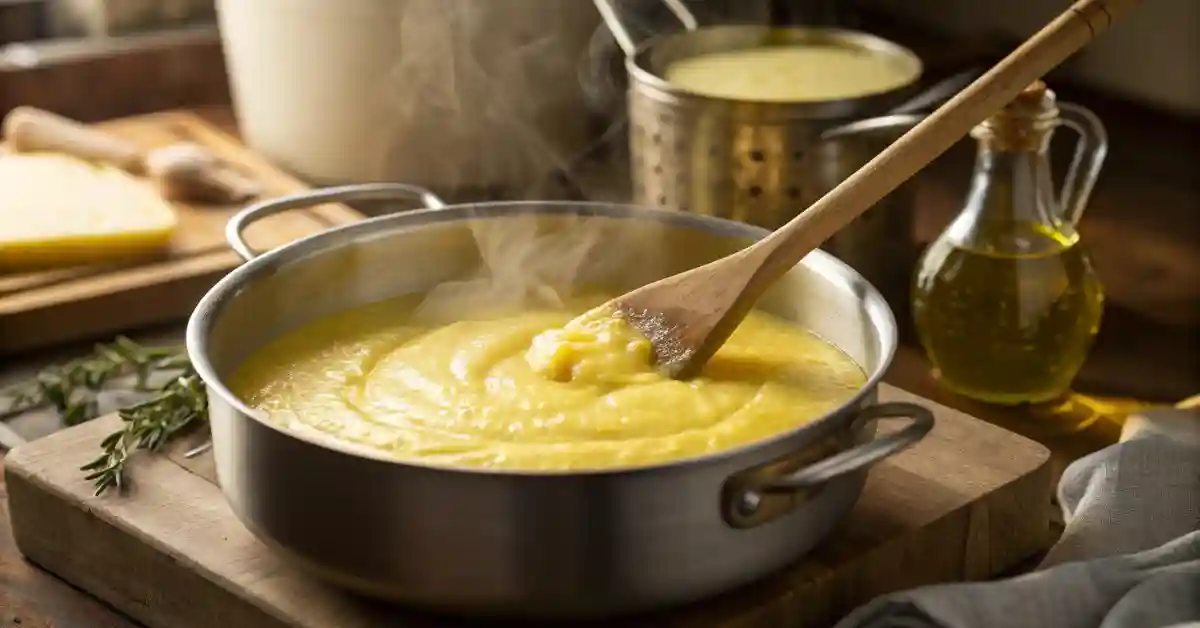
2. Sauté the Greens
- Heat olive oil in a skillet over medium heat.
- Add garlic and cook for 30 seconds.
- Add greens and cook until wilted, about 3–4 minutes.
- Season with salt, pepper, and chili flakes if desired.

3. Poach the Eggs
- Fill a small pot with 2–3 inches of water and add vinegar.
- Bring to a gentle simmer.
- Crack each egg into a small bowl.
- Swirl the water to create a whirlpool, then gently slide in the egg.
- Poach for 3 minutes, then lift out with a slotted spoon and drain.
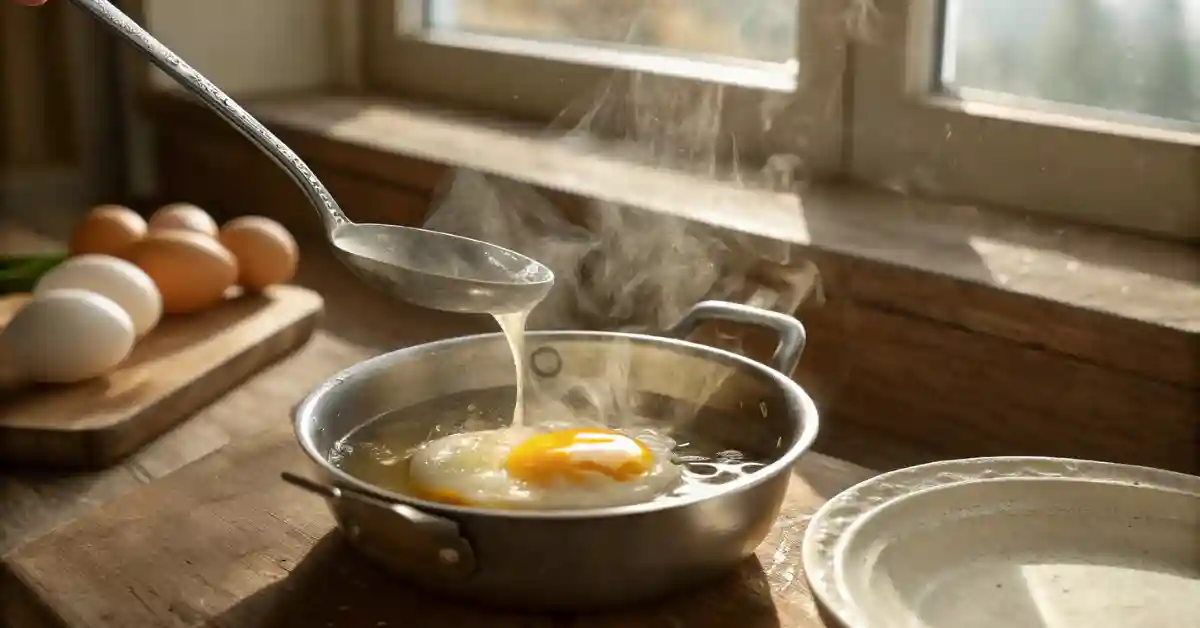
4. Assemble Your Bowl
- Divide polenta into bowls.
- Top with sautéed greens.
- Place one poached egg on each bowl.
- Add toppings and garnish with herbs, cheese, or lemon zest.
And there you have it—a warm, hearty, and nutrient-rich Polenta with Eggs and Greens you can enjoy any time of day.
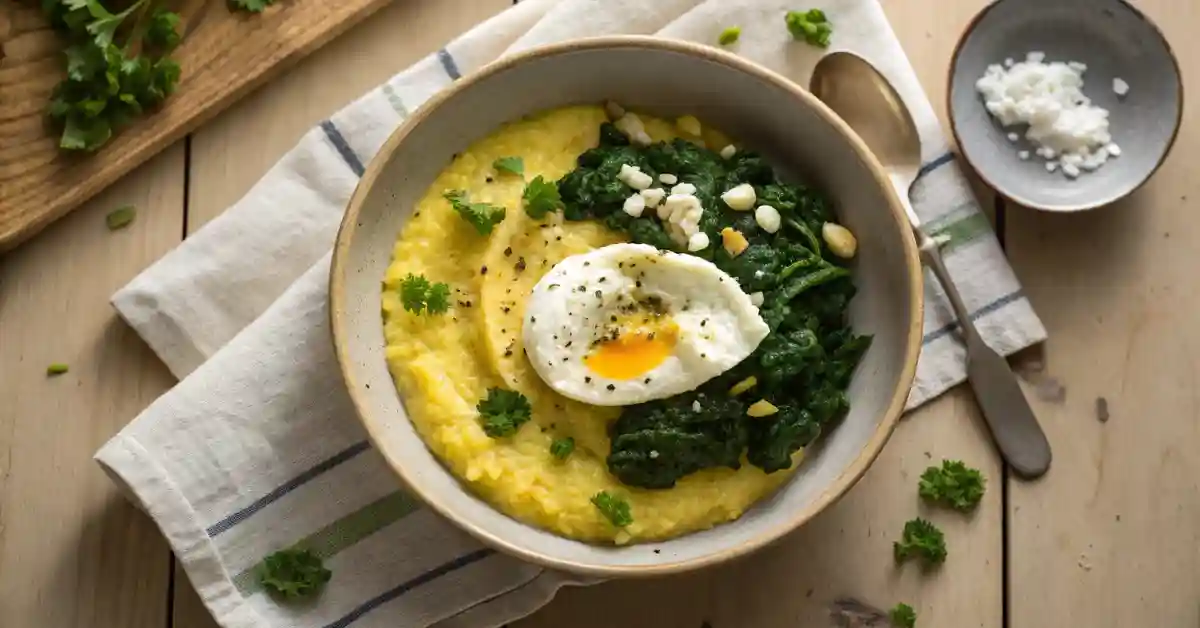
Make-Ahead Magic: How to Prep Polenta with Eggs and Greens Like a Pro
Want to get ahead of the game? Here’s how:
- Polenta can be made up to 3 days ahead and stored in the fridge. Reheat with a splash of water or broth.
- Greens can be sautéed and refrigerated for up to 2 days.
- Eggs are best poached fresh, but soft-boiled eggs (cooked 6–7 minutes) hold well and reheat beautifully.
For a grab-and-go version, pour the cooked polenta into a baking dish, chill, slice, and reheat individual portions. Top with prepped greens and a quick egg before serving.
FAQs About Polenta with Eggs and Greens
Can you add egg to polenta?
Yes, you can absolutely add egg to polenta. One method is to stir a raw egg into hot cooked polenta to give it a creamy, custard-like texture. This works particularly well if you’re baking it or preparing a firm version. Another popular approach—especially in Polenta with Eggs and Greens—is to poach or fry an egg and place it directly on top of the creamy polenta and sautéed greens. The runny yolk acts like a sauce and elevates the entire dish.
What is traditionally served with polenta?
Traditionally, polenta is served with hearty accompaniments like slow-cooked meats, mushroom ragùs, or rich cheeses in Northern Italy. But in modern Mediterranean cuisine, lighter pairings are favored. That’s why Polenta with Eggs and Greens has become a popular variation—it takes the base and pairs it with wholesome toppings like leafy greens, poached eggs, and herbs, making it perfect for breakfast, brunch, or light dinner.
How does Gordon Ramsay cook polenta?
Gordon Ramsay cooks polenta slowly over low heat, using a 4:1 ratio of water to cornmeal. He stirs it constantly to ensure a smooth, lump-free texture and finishes with cream and butter for richness. If you’re making Polenta with Eggs and Greens, you can follow Ramsay’s method but replace butter with olive oil and finish with grated Parmesan or Pecorino Romano for a Mediterranean spin.
What do Italians do with polenta?
Italians do a lot with polenta—it’s a foundational food in the north. They serve it soft, grilled, baked, or even sliced and fried. It’s used under stews, as a main dish with mushrooms, or cooled and used in baked casseroles. The modern interpretation, Polenta with Eggs and Greens, isn’t necessarily traditional, but it reflects Italian values of simplicity, local ingredients, and comfort.
Do Southern Italians eat polenta?
Southern Italians eat polenta less frequently than Northerners, but it still appears in regional dishes. In Calabria, a thicker version called frascatula is made with cornmeal and seasonal wild greens. While eggs are less common in traditional southern polenta dishes, the use of sautéed greens is very much in line with the Polenta with Eggs and Greens concept, making it a cross-cultural Mediterranean dish.
Is polenta healthy?
Yes, polenta is healthy—especially when made from whole-grain cornmeal and paired with nutrient-rich toppings. It’s naturally gluten-free and low in fat. Add greens like spinach or kale, and eggs for protein, and you have a balanced bowl. That’s the magic of Polenta with Eggs and Greens—a dish that tastes indulgent but supports wellness.
Why You Should Try Polenta with Eggs and Greens Today
There’s something special about a dish that feels both timeless and modern, rustic yet elegant. Polenta with Eggs and Greens fits perfectly into that sweet spot. It brings together creamy comfort, fresh garden produce, and the richness of a golden egg—all in one nourishing bowl.
Whether you enjoy Polenta with Eggs and Greens for a slow weekend brunch, a light yet filling dinner, or even meal-prepped weekday lunches, this Mediterranean classic is versatile, gluten-free, and endlessly customizable. From Northern Italian kitchens to California brunch tables, Polenta with Eggs and Greens is a dish that honors the past while embracing today’s taste for healthy, home-cooked meals.
If you’re new to polenta or just looking for a new way to enjoy eggs and greens,Polenta with Eggs and Greens is your sign to make it. Simple ingredients. Big flavors. Feel-good food.
Discover more Mediterranean comfort dishes like this one in our gluten-free recipe collection:
👉 Don’t miss our gluten-free Mediterranean favorites



